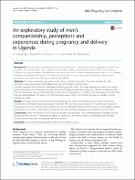| dc.contributor.author | Lwanga, H. | |
| dc.contributor.author | Atuyambe, L. | |
| dc.contributor.author | Sempewo, H. | |
| dc.contributor.author | Lumala, A. | |
| dc.contributor.author | Byaruhanga, R. N. B. | |
| dc.date.accessioned | 2021-10-27T12:54:01Z | |
| dc.date.available | 2021-10-27T12:54:01Z | |
| dc.date.issued | 2017-06-19 | |
| dc.identifier.citation | Lwanga, H., Atuyambe, L., Sempewo, H., Lumala, A. and Byaruhanga, R.N.B., 2017. An exploratory study of men’s companionship, perceptions and experiences during pregnancy and delivery in Uganda. BMC pregnancy and childbirth, 17(1), pp.1-8. | en_US |
| dc.identifier.issn | 1471-2393 | |
| dc.identifier.uri | http://hdl.handle.net/20.500.12280/2844 | |
| dc.description.abstract | Background: Globally, low involvement of men in maternal health care services remains a problem to health care
providers and policy makers. Men’s support is essential for making women’s world better. There are increasing
debates among policymakers and researchers on the role of men in maternal health programs, which is a challenge
in patriarchal societies like Uganda. The aim of the study was to assess companionship during delivery; men’s
perception and experiences during pregnancy and delivery.
Methods: This was a descriptive exploratory study using a qualitative approach. This study involved 16 male
participants who were present in the labor room during the delivery of their child.
In-depth interviews (IDIs) were the main data collection methods used in the study. Purposive sampling was used to
select participants who share particular characteristics with the potential of providing rich, relevant, and diverse data.
The interviews were tape-recorded with the permission of the participants; in addition, the interviewer took notes. Each
interview lasted between 30 and 45 min. The transcripts were entered into ATLAS.ti for analysis. Manifest content
analysis was used.
Results: The major themes were; feelings about attending child birth, responsibilities during child birth, positive
experiences and negative experiences about child birth. Men are willing to participate in child birth and should be
encouraged as many are the decision makers in the family. Admission of men into the delivery room, improves family
togetherness. The women felt loved and treasured. The men reported bondage to their partners and new born.
Conclusions: Men’s involvement in the child birth process was associated with a more perceived bondage with the
partner and the newborn. Their presence helped to promote a calm and successful child birth process. Hospitals
should work on measures encouraging male involvement. | en_US |
| dc.language.iso | en | en_US |
| dc.publisher | BMC | en_US |
| dc.relation.ispartofseries | BMC pregnancy and childbirth;17:196 | |
| dc.subject | Companionship during delivery | en_US |
| dc.subject | Men’s involvement | en_US |
| dc.subject | Uganda | en_US |
| dc.title | An exploratory study of men’s companionship, perceptions and experiences during pregnancy and delivery in Uganda2017 | en_US |
| dc.type | Article | en_US |


